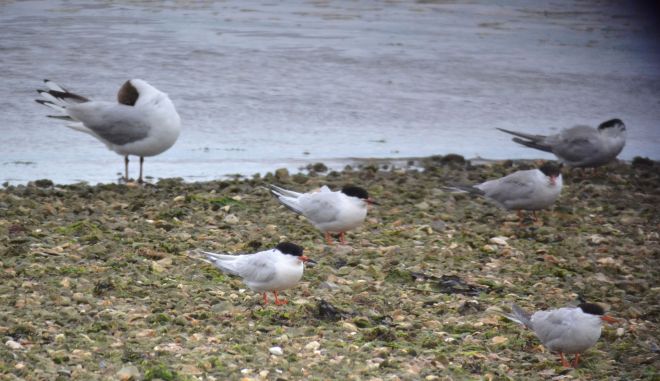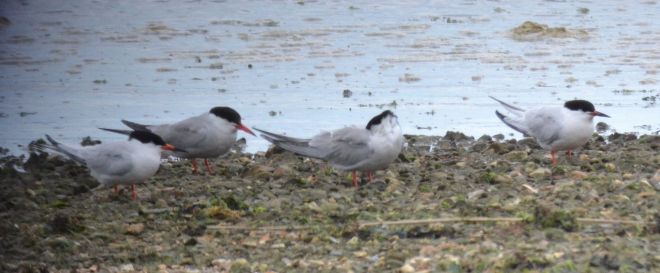This is a bird I really should have connected with long before now, but one circumstances have always seemed to conspire against. One of only two regularly occurring migratory Terns in Europe I had not observed until now (the other being Sooty), there are good numbers of British records each year. So most seasoned birders will have it on their lists. These credentials all gave Roseate Tern “huge lifer” status.
My long standing ill luck concerning this species looked set to continue when on going away from home a week ago two adult Roseate were reported daily during my absence at a convenient location, the Solent by Titchfield Haven NNR. Mid-July is when failed breeders begin to move around, and birds were also reported from other places nationally. Then upon my return last Saturday the Hants Terns relocated to Poole Harbour though not for long.

Two adult Roseate Terns (centre) with Common Terns (right)
Yesterday (16th) they were back on the Solent, resuming a routine of loafing with Common Terns and Gulls on mud and shingle by Hill Head Harbour (SU534023), then moving onto the adjacent reserve’s Meon Shore scrape at high tide. I didn’t hear about their return until mid-afternoon, and my first reaction was to go down the following morning. That thought lasted about five minutes before I upped and went, and didn’t the buzz that comes from a bijou twitchette such as this feel good.
I arrived 80 miles later at some time after 5pm to find the tide lapping against the sea wall and Titchfield Haven already closed to the public. It would be wrong to take issue with that, since the reserve is manned by volunteers and health and safety legislation no doubt rules against visitors entering out of hours, but such an early 5pm closure was still inconvenient. I checked through the Terns on the nearest lagoon, then explored further to ascertain there were indeed no viewpoints from where the scrape could be viewed from distance.
Returning to Hill Head Harbour at around 6pm I found the tide was going out again and Terns were beginning to congregate on the exposed “beach”. Two more birders joined me and for the next 90 minutes we watched the comings and goings on the falling tide, though all of the Terns present were Common. But this morning (17th) the Roseates were reported again first thing from this exact same spot and so I reverted to plan A.
The second attempt was at the opposite end of the fortune scale to the first. On re-arriving at around 11am I enquired of a departing birder, to be told the two adult Roseate Tern were out on the shingle and a few people were watching them from the sea wall. I parked (it’s free here) then hurried over, observing my usual priorities of see the bird first, get any kind of picture, then try for a better picture. Someone told me where to look and one Tern immediately stood out as being different. Then I found the second Roseate.
I had got here just in time since shortly afterwards the birds flew out into the Solent to feed. I then walked around the harbour to join more birders sitting on a breakwater and when the Terns came back I took all of the digiscoped pictures herein. One predictable outcome of this post’s return to bird matters is a reduction in image quality, but I can see what these birds are. I even learned to recognise their distinctive, high-pitched call as they came and went. When the tide came right in they flew off again towards the Meon Shore scrape.
To quote the Helm guide to confusion species, Roseate Tern is slightly smaller and more delicate than Common with shorter, narrower wings; and even longer tail streamers than Arctic Tern. The previous evening I had concentrated on looking for more black in the bill. But having now read up on other diagnostics before setting out I at once picked out the pale upper side, lack of black in the tail and very bright legs that my earlier companions had discussed. All these features show fairly well in the picture that heads up this post and the two blurry crops above. The difference from the greyer-toned Common Terns was striking.

In this picture the Roseate Terns are the paler-toned outer birds
Currently in 2018 there are around 116 breeding pairs of Roseate Tern in the UK (per RBA), restricted mainly to Coquet Island in Northumberland with a few pairs scattered elsewhere. A much larger population occurs in Ireland. The species takes its name from a pink tinge that is visible on the breast during the breeding season. Small post-breeding numbers are seen on migration in southern and eastern English counties, and it was an absolute pleasure to finally catch up with this very attractive Tern today.


